Roden 1/48 Sea Gladiator
Once the Royal Navy lost control of their air arm with the consolidation of the Royal Flying Corps and Royal Naval Air Service into the Royal Air Force in April, 1918, the service that had pioneered the naval use of aircraft and the ships to operate them was gradually outdistanced by both the U.S. Navy and the Imperial Japanese Navy during the intervening years before the outbreak of the Second World War. For instance, the Fairey Flycatcher of the late 1920s-early 1930s might have been wonderful to fly, but it was completely outperformed by the Boeing F4B series of naval fighters in the U.S. With flying officers not even serving in the Navy until the service regained control of the Fleet Air Arm in 1938, there was virtually no communication between the Royal Navy and the Royal Air Force; naval requirements took a back seat to the needs of the Royal Air Force for its land-based squadrons, and the Navy had to make do with aircraft that were mostly navalized versions of land-based aircraft. By the mid-1930s, with the premiere British naval fighter being the Hawker Nimrod at a time when the Japanese were introducing the A5M "Claude" and the U.S. Navy was introducing the Grumman F3F series, British naval aviation was definitely in the second rank.
While there were designs in progress, with war clouds gathering in late 1938 when the Nimrod was thoroughly obsolete, the Navy urgently needed a new fighter with at least a chance of holding its own over the ocean, where the likely opponent would not be operating single-engine fighters. The Admiralty was able to obtain sixty aircraft on the RAF's Gladiator II contract (N5500-N5549 and N5565-N5574) on May 24, 1939 as Sea Gladiators. Prior to this, 14 Gladiator IIs were fitted with arrester hooks, with others utilized for familiarization training and were not intended for operational use aboard carriers. Both the Watts wooden two-blade prop and the Fairey-Reed metal prop were tested; while it was concluded that the Watts propeller was much superior for carrier operations, it was decided to standardize on the Fairey-Reed prop for the Sea Gladiators under construction. In the end, the only difference between the Sea Gladiator and the Gladiator II was the installation of an A-frame arrestor hook below the rear fuselage ahead of the tail wheel, and dinghy carried in a container between the landing gear legs.
The first Sea Gladiators went to 801 Squadron aboard HMS "Courageous" at the end of May, 1939, with all the Sea Gladiators delivered by the end of 1939 following the outbreak of war on September 3.
The Sea Gladiator first entered combat on April 22, 1940 during the German invasion of Norway, when Sea Gladiators of 804 Squadron aboard HMS "Glorious" intercepted several Heinkel bombers and shot down three while Gladiator IIs of 263 Squadron, RAF, were being ferried to Lake Lesja.
By 1940, when Italy entered the war, the Royal Navy and the Fleet Air Arm were stretched thin. While the story of the SEa Gladiators of the Hal Far flight at Malta have received much recognition for their role as the sole air defense of the island during the opening stages of the air war aimed at reducing it, there was another flight of Sea Gladiators operational in the Mediterranean which also provided sterling service.
At the outbreak of war in the Mediterranean, HMS Eagle - the sole fleet carrier in the Med at the time - did not carry a fighter squadron. Four Sea Gladiators - N5512, N5513, N5517 and N5567 - were hurriedly withdrawn from storage on Malta, assembled, and taken aboard the carrier on June 16, 1940. The Eagle Fighter Flight was commanded by CDR Charles Keighly-Peach, who managed to train several Fairey Swordfish pilots in fighter tactics.
Almost one month later, on July 11, 1940, the British Mediterranean Fleet was spotted by an Italian flying boat. Though the Sea Gladiators intercepted and made contact, their initial attacks were unsuccessful. That afternoon, Keighly-Peach - known as K-P to his men - was on patrol over the fleet in N5517/6-A, in company with Lt. Kenneth Keith in N5513 when he spotted five S.79s below him, heading toward the ships. The two Sea Gladiators dove vertically on the Italian bombers, with K-P heading for the lead plane as he closed to less than 50 yards before opening fire. After three attacks, the Italian leader caught fire and dropped back, before entering a spin and impacting the sea with no survivors. K-P was wounded in the thigh during the attack. The two Sea Gladiators had to break off their attacks on the other S.79s as the fleet opened fire.
On July 14, K-P was launched at dawn south of Crete. At 0750, he spotted a lone S.79 and made three attacks from out of the sun, with the result that this Sparviero also caught fire and spun into the ocean. Three hours later, in company again with Lt. Keith, the two Sea Gladiators spotted three more S.79s approaching the fleet. Keith opened fire on the left-hand Sparviero, joined by K-P, and the unfortunate Italian crashed into the sea from their combined fire. A few hours later, Keith was launched alone to intercept a formation of S.81s from 200 Squadriglia; after a beam attack and a stern chase, he sent one of these into the sea, to mark the end of a very successful day for the flight. On July 29th, K-P intercepted another formation of S.79s and sent his third Sparviero into the sea.
The next month, Eagle's Sea Gladiators were sent ashore to Sidi Barani to provide fleet defense with RAF Gladiators when the fleet bombarded the Libyan port of Bardia. On August 17, separated from his flight over the British fleet, Keighly-Peach attacked two separate S.79s, forcing them to break off their attacks though not shooting them down. Lt. Keith bagged another S.79 in company with a Gladiator from 112 Squadron RAF. Overall, the Italians lost 4 bombers destroyed and several damaged in this action.
Again off Crete on August 31, K-P was launched with Lt. Oliphant to intercept a shadower, which turned out to be a Cant Z.506B at 6,000 feet. K-P shot the floatplane down, with the crew escaping by parachute. It was his last victory, making him the leading FAA fighter pilot on the Sea Gladiator; he was awarded the DSO the following month for his leadership of the Eagle Fighter Flight and his achievements over the fleet.
Also in early September, HMS "Illustrious" arrived in the Mediterranean with a full compliment of Fulmars in 806 Squadron, and "Eagle's" foursome were no longer the only Fleet Air Arm fighters in the region; they were then designated 813 Squadron. On 6 November, 806 Squadron took aboard three Sea Gladiators from 813 Squadron, as the carrier was tasked with covering two convoys to Malta. On November 8, 1940, Lt. Roger Nichols in N5549 and Sub. Lt. Jack Sewell in N5513 destroyed a Cant Z.501, to record the last victory of the Sea Gladiator at sea.
On January 10, 1941, following arrival of "Illustrious" at Malta with another convoy, the three Sea Gladiators were off-loaded and turned over to 261 Squadron on the island, which was down to four effective fighters after heavy attacks. On January 24, 1941, Sub. Lt. Sewell spotted a German Ju-88 diving toward Hal Far, and shot it down. It was Sewell's fifth of an eventual 6 victories scored with Sea Gladiators and Fulmars, and also the last victory by a Sea Gladiator over Malta.
This model was built back in 2003 when roden first released their Gladiators. I think the series are the best Gladiator kits available; they're now out of production but worth tracking down if you want on. They're certainly vastly superior to the 50-year old Merit kit that has been released by Pyro and Lindberg. The Roden Sea Gladiator differs from their other Gladiator kits by providing a Fairey-Reed three-blade prop and the liferaft pack that goes between the landing gear legs. The decals are not the proper size for the aircraft provided according to photos. I was able to piece together the markings for K-P's Sea Gladiator from an Aeromaster Gladiator sheet and other decals in the dungeon.
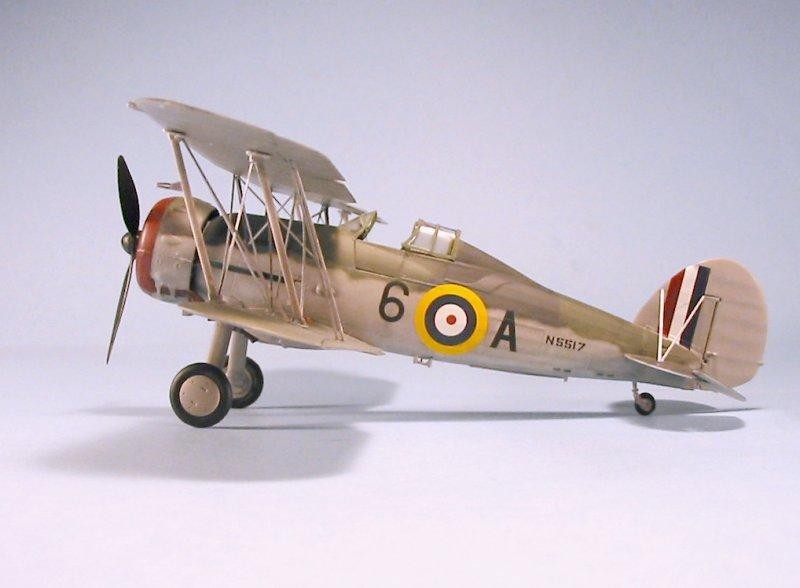
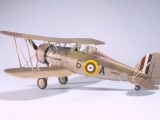
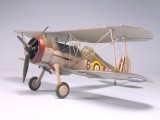
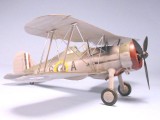
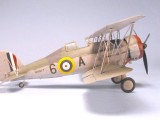
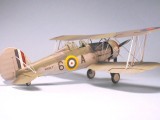
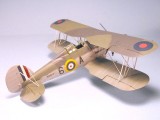
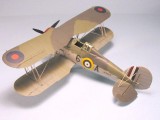
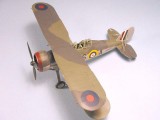
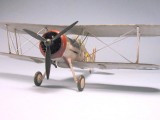
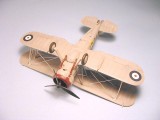
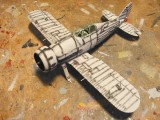
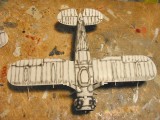
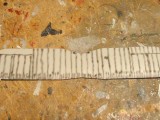
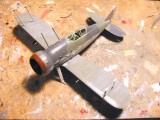
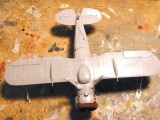
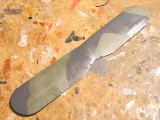
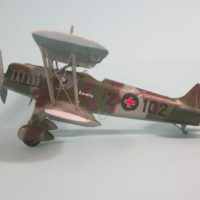

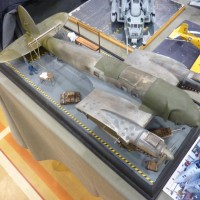
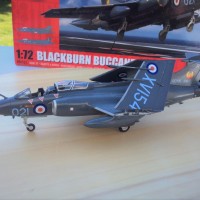
Though not my area of interest, a fine-looking model nonetheless (as well as the photography).
Tom, not Merit, Inpact, who had the Gladiator, Bulldog, Flycatcher, and Fury.
Roamin' molds, since, Pyro, Lifelike, and Lindberg.
State of the art stuff in 1968, and the first models I bought when I got back from Six Flags Over Nothing. Like Freddy Kruger, they just keep on coming, though with a better result.
Always glad to see Royal Navy aircraft.
Great work on this!
Nice looking model, Tom. Looks like you have the differing, split camo between the upper and lower planes, similar to the Swordfish.
You did a great job on this one Tom. Well done!
Very nice. One of the nicest colour schemes too. Great job.
Tom,
Excellent. Great job on a great airplane.
Great narrative, nice build as always.
Nice build Tom and , as ever an excellent story behind it.
sweet model man